MITSUBISHI ECLIPSE CROSS 2019 (in English) Owner's Guide
Manufacturer: MITSUBISHI, Model Year: 2019, Model line: ECLIPSE CROSS, Model: MITSUBISHI ECLIPSE CROSS 2019Pages: 423, PDF Size: 75.41 MB
Page 21 of 423
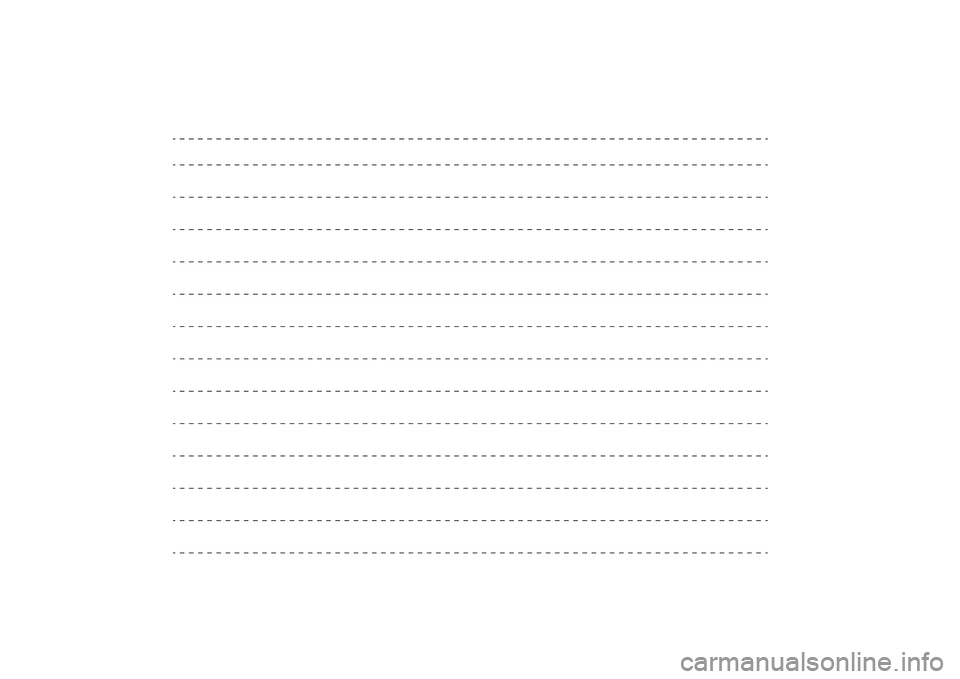
BK0266800US.book 8 ページ 2018年6月27日 水曜日 午後5時6分
Page 22 of 423
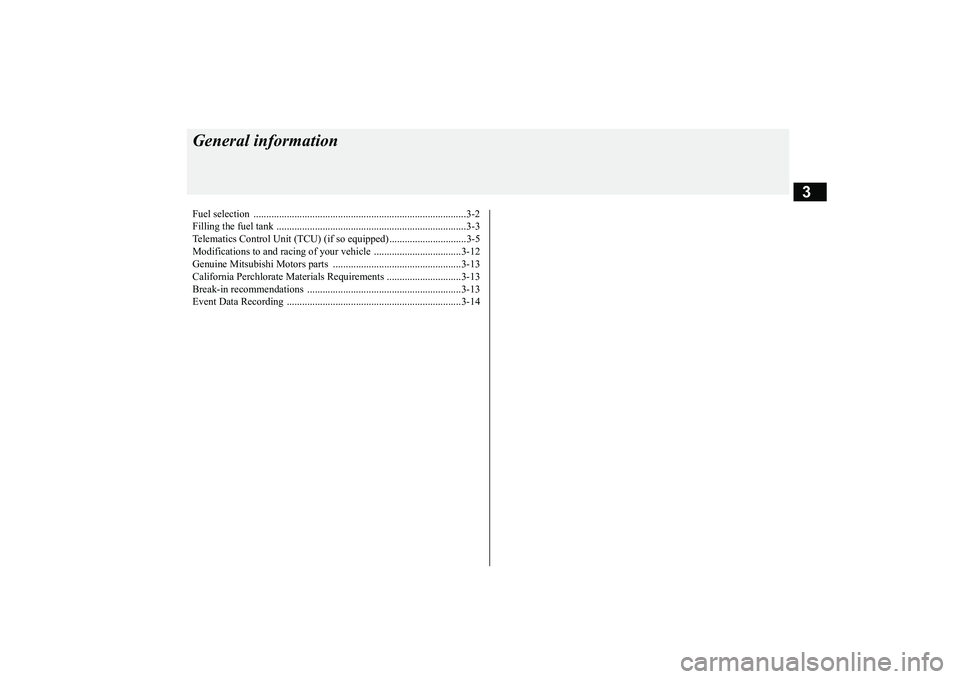
3
General informationFuel selection ..................
.................................................................3-2
Filling the fuel tank
................................................
..........................3-3
Telematics Control Unit (TCU) (if so equipped) ..............................3-5 Modifications to and racing
of your vehicle ..................................3-12
Genuine Mitsubishi Motors parts ..................................................3-13 California Perchlorate Materials Requirements .............................3-13 Break-in recommendation
s ............................................................3-13
Event Data Recording
............................................
........................3-14
BK0266800US.bo
ok 1 ページ 2018年6月27日 水曜日 午後5時6分
Page 23 of 423
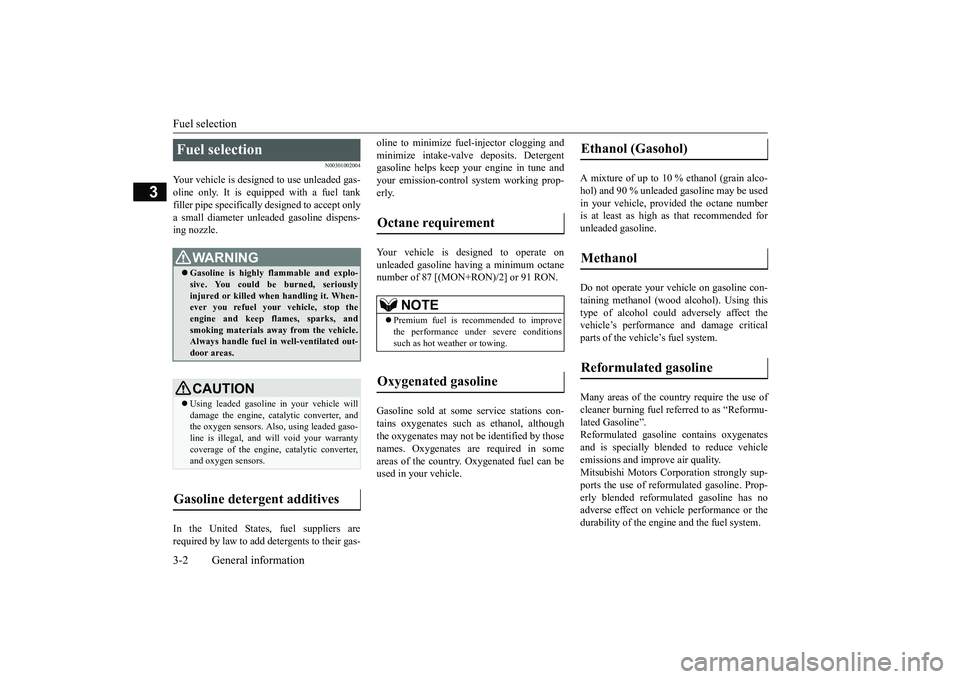
Fuel selection 3-2 General information
3
N00301002004
Your vehicle is designed to use unleaded gas- oline only. It is equipped with a fuel tankfiller pipe specifically designed to accept only a small diameter unleaded gasoline dispens- ing nozzle. In the United States, fuel suppliers are required by law to add detergents to their gas-
oline to minimize fuel-injector clogging and minimize intake-valve deposits. Detergent gasoline helps keep your engine in tune and your emission-control system working prop-erly. Your vehicle is designed to operate on unleaded gasoline having a minimum octanenumber of 87 [(MON+RON)/2] or 91 RON. Gasoline sold at some service stations con- tains oxygenates such as ethanol, although the oxygenates may not be identified by thosenames. Oxygenates are required in some areas of the country. Oxygenated fuel can be used in your vehicle.
A mixture of up to 10 % ethanol (grain alco- hol) and 90 % unleaded gasoline may be usedin your vehicle, provided the octane number is at least as high as that recommended for unleaded gasoline. Do not operate your vehicle on gasoline con- taining methanol (wood alcohol). Using this type of alcohol could adversely affect thevehicle’s performance and damage critical parts of the vehicle’s fuel system. Many areas of the country require the use of cleaner burning fuel referred to as “Reformu- lated Gasoline”.Reformulated gasoline contains oxygenates and is specially blended to reduce vehicle emissions and improve air quality.Mitsubishi Motors Cor
poration strongly sup-
ports the use of reformulated gasoline. Prop- erly blended reformulated gasoline has noadverse effect on vehicle performance or the durability of the engine and the fuel system.
Fuel selection
WA R N I N G Gasoline is highly flammable and explo- sive. You could be burned, seriouslyinjured or killed when handling it. When- ever you refuel your vehicle, stop the engine and keep flames, sparks, andsmoking materials away from the vehicle. Always handle fuel in well-ventilated out- door areas.CAUTION Using leaded gasoline in your vehicle will damage the engine, catalytic converter, and the oxygen sensors. Also, using leaded gaso-line is illegal, and will void your warranty coverage of the engine, catalytic converter, and oxygen sensors.
Gasoline detergent additives
Octane requirement
NOTE
Premium fuel is recommended to improve the performance under severe conditions such as hot w
eather or towing.
Oxygenated gasoline
Ethanol (Gasohol) Methanol Reformulated gasoline
BK0266800US.bo
ok 2 ページ 2018年6月27日 水曜日 午後5時6分
Page 24 of 423
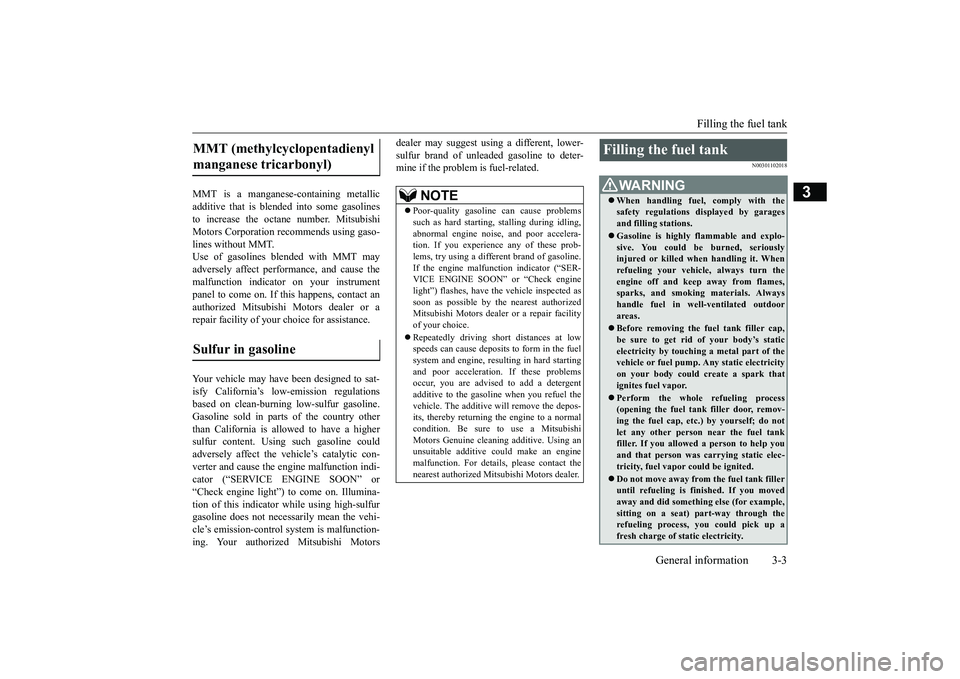
Filling the fuel tank
General information 3-3
3
MMT is a manganese-containing metallic additive that is blended into some gasolines to increase the octane number. Mitsubishi Motors Corporation recommends using gaso-lines without MMT. Use of gasolines blended with MMT may adversely affect performance, and cause themalfunction indicator on your instrumentpanel to come on. If this happens, contact an authorized Mitsubishi Motors dealer or a repair facility of your choice for assistance. Your vehicle may have been designed to sat- isfy California’s low-emission regulationsbased on clean-burning low-sulfur gasoline. Gasoline sold in parts of the country other than California is allowed to have a highersulfur content. Using such gasoline could adversely affect the vehicle’s catalytic con- verter and cause the engine malfunction indi-cator (“SERVICE ENGINE SOON” or “Check engine light”) to come on. Illumina- tion of this indicator while using high-sulfurgasoline does not necessarily mean the vehi- cle’s emission-control system is malfunction- ing. Your authorized Mitsubishi Motors
dealer may suggest using a different, lower- sulfur brand of unleaded gasoline to deter- mine if the problem is fuel-related.
N00301102018
MMT (methylcyclopentadienyl manganese tricarbonyl) Sulfur in gasoline
NOTE
Poor-quality gasoline can cause problems such as hard starting, stalling during idling, abnormal engine noise, and poor accelera- tion. If you experience any of these prob-lems, try using a different brand of gasoline. If the engine malfunction indicator (“SER- VICE ENGINE SOON” or “Check enginelight”) flashes, have the vehicle inspected as soon as possible by the nearest authorized Mitsubishi Motors dealer or a repair facilityof your choice. Repeatedly driving short distances at low speeds can cause deposits to form in the fuel system and engine, resulting in hard starting and poor acceleration. If these problemsoccur, you are advised to add a detergent additive to the gasoline when you refuel the vehicle. The additive will remove the depos-its, thereby returning the engine to a normal condition. Be sure to use a Mitsubishi Motors Genuine cleaning additive. Using anunsuitable additive could make an engine malfunction. For details, please contact the nearest authorized Mitsubishi Motors dealer.
Filling the fuel tank
WA R N I N G When handling fuel, comply with the safety regulations displayed by garages and filling stations. Gasoline is highly flammable and explo- sive. You could be burned, seriously injured or killed when handling it. Whenrefueling your vehicle, always turn the engine off and keep away from flames, sparks, and smoking materials. Alwayshandle fuel in well-ventilated outdoor areas. Before removing the fuel tank filler cap, be sure to get rid of your body’s static electricity by touching a metal part of thevehicle or fuel pump. Any static electricity on your body could create a spark that ignites fuel vapor. Perform the whole refueling process (opening the fuel tank filler door, remov-ing the fuel cap, etc.) by yourself; do not let any other person near the fuel tank filler. If you allowed a person to help youand that person was carrying static elec- tricity, fuel vapor could be ignited. Do not move away from the fuel tank filler until refueling is finished. If you movedaway and did something else (for example, sitting on a seat) part-way through the refueling process, you could pick up afresh charge of static electricity.
BK0266800US.bo
ok 3 ページ 2018年6月27日 水曜日 午後5時6分
Page 25 of 423
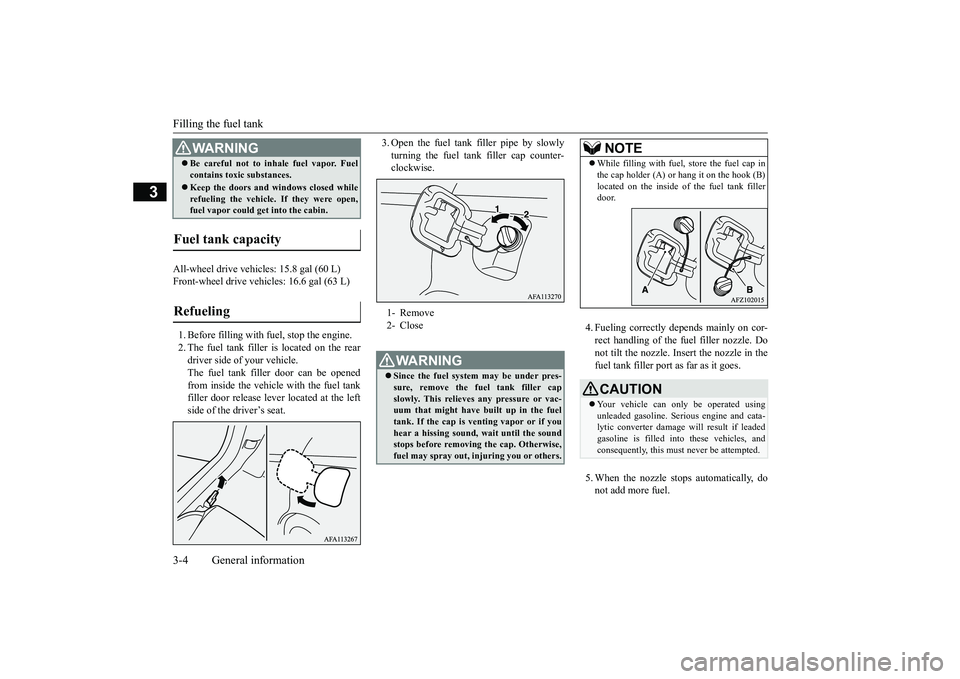
Filling the fuel tank 3-4 General information
3
All-wheel drive vehicles: 15.8 gal (60 L) Front-wheel drive vehicles: 16.6 gal (63 L) 1. Before filling with fuel, stop the engine. 2. The fuel tank filler is located on the rear driver side of your vehicle. The fuel tank filler door can be openedfrom inside the vehicle with the fuel tank filler door release le
ver located at the left
side of the driver’s seat.
3. Open the fuel tank filler pipe by slowly turning the fuel tank filler cap counter- clockwise.
4. Fueling correctly depends mainly on cor- rect handling of the fuel filler nozzle. Do not tilt the nozzle. Insert the nozzle in thefuel tank filler port as far as it goes. 5. When the nozzle stops automatically, do not add more fuel.
Be careful not to inhale fuel vapor. Fuel contains toxic substances. Keep the doors and windows closed while refueling the vehicle. If they were open,fuel vapor could get into the cabin.
Fuel tank capacity Refueling
WA R N I N G
1- Remove 2- CloseWA R N I N G Since the fuel system may be under pres- sure, remove the fuel tank filler cap slowly. This relieves any pressure or vac- uum that might have built up in the fueltank. If the cap is venting vapor or if you hear a hissing sound, wait until the sound stops before removing the cap. Otherwise,fuel may spray out, injuring you or others.
NOTE
While filling with fuel, store the fuel cap in the cap holder (A) or hang it on the hook (B) located on the inside of the fuel tank filler door.CAUTION Your vehicle can only be operated using unleaded gasoline. Serious engine and cata- lytic converter damage will result if leadedgasoline is filled into these vehicles, and consequently, this must never be attempted.
BK0266800US.bo
ok 4 ページ 2018年6月27日 水曜日 午後5時6分
Page 26 of 423
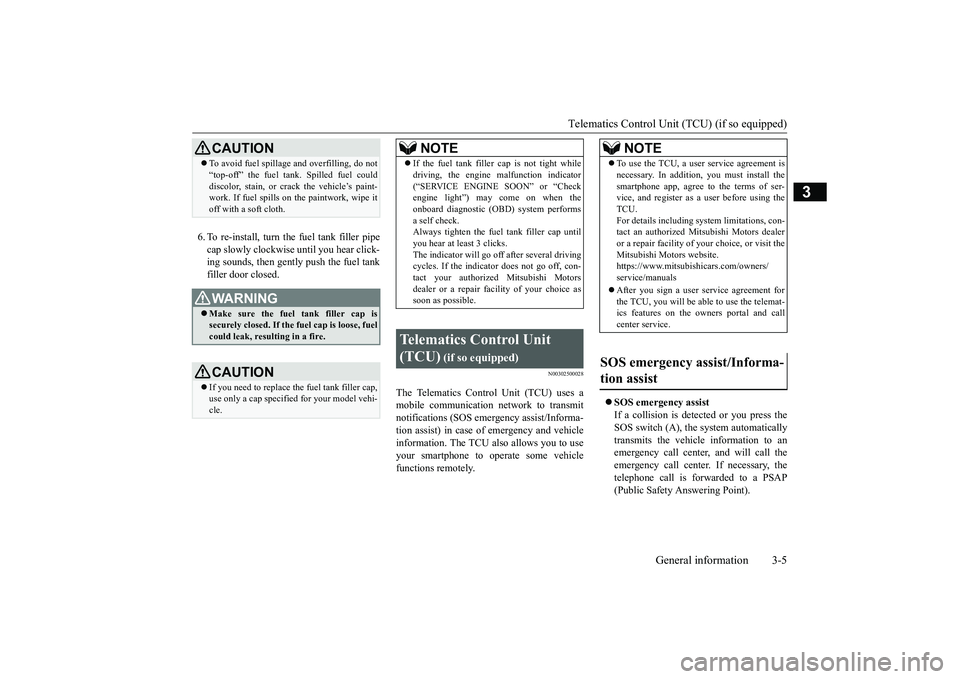
Telematics Control Unit (TCU) (if so equipped)
General information 3-5
3
6. To re-install, turn the fuel tank filler pipe cap slowly clockwise until you hear click- ing sounds, then gently push the fuel tank filler door closed.
N00302500028
The Telematics Control Unit (TCU) uses amobile communication network to transmitnotifications (SOS emergency assist/Informa- tion assist) in case of emergency and vehicle information. The TCU also allows you to useyour smartphone to operate some vehicle functions remotely.
SOS emergency assist If a collision is detected or you press the SOS switch (A), the system automaticallytransmits the vehicle information to an emergency call center, and will call the emergency call center. If necessary, thetelephone call is forwarded to a PSAP (Public Safety Answering Point).
CAUTION To avoid fuel spillage and overfilling, do not “top-off” the fuel tank. Spilled fuel could discolor, stain, or crack the vehicle’s paint- work. If fuel spills on the paintwork, wipe it off with a soft cloth.WA R N I N G Make sure the fuel tank filler cap is securely closed. If the fuel cap is loose, fuel could leak, resulting in a fire.CAUTION If you need to replace the fuel tank filler cap, use only a cap specified for your model vehi- cle.
NOTE
If the fuel tank filler
cap is not tight while
driving, the engine malfunction indicator (“SERVICE ENGINE SOON” or “Check engine light”) may come on when the onboard diagnostic (OBD) system performsa self check. Always tighten the fuel tank filler cap until you hear at least 3 clicks.The indicator will go off after several driving cycles. If the indicator does not go off, con- tact your authorized Mitsubishi Motorsdealer or a repair facility of your choice as soon as possible.
Telematics Control Unit (TCU)
(if so equipped)
NOTE
To use the TCU, a user service agreement is necessary. In addition, you must install the smartphone app, agree to the terms of ser- vice, and register as a user before using the TCU.For details including system limitations, con- tact an authorized Mitsubishi Motors dealer or a repair facility of
your choice, or visit the
Mitsubishi Motors website. https://www.mitsubishicars.com/owners/ service/manuals After you sign a user service agreement for the TCU, you will be able to use the telemat-ics features on the owners portal and call center service.
SOS emergency assist/Informa- tion assist
BK0266800US.bo
ok 5 ページ 2018年6月27日 水曜日 午後5時6分
Page 27 of 423
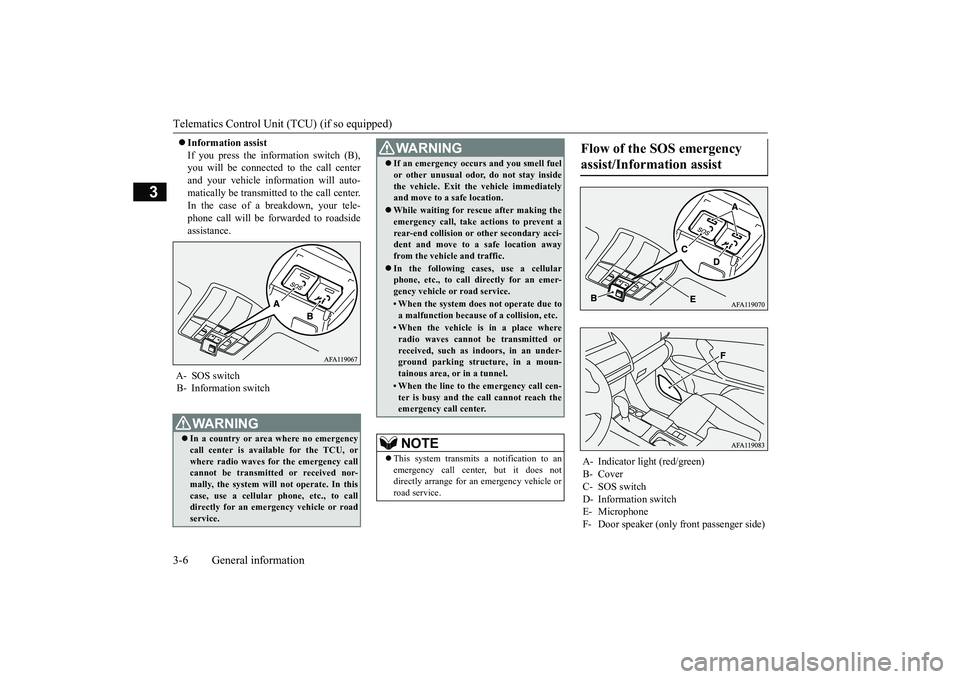
Telematics Control Unit (TCU) (if so equipped) 3-6 General information
3
Information assist If you press the information switch (B), you will be connected to the call center and your vehicle information will auto-matically be transmitted to the call center. In the case of a breakdown, your tele- phone call will be forwarded to roadsideassistance.
A- SOS switch B- Information switch
WA R N I N G In a country or area where no emergency call center is available for the TCU, or where radio waves for the emergency callcannot be transmitted or received nor- mally, the system will not operate. In this case, use a cellular phone, etc., to calldirectly for an emergency vehicle or road service.
If an emergency occurs and you smell fuel or other unusual odor, do not stay inside the vehicle. Exit the vehicle immediately and move to a safe location. While waiting for rescue after making the emergency call, take actions to prevent a rear-end collision or other secondary acci-dent and move to a safe location away from the vehicle and traffic. In the following cases, use a cellular phone, etc., to call directly for an emer- gency vehicle or road service.• When the system does not operate due toa malfunction because of a collision, etc.• When the vehicle is in a place whereradio waves cannot be transmitted orreceived, such as indoors, in an under- ground parking structure, in a moun- tainous area, or in a tunnel.• When the line to the emergency call cen-ter is busy and the call cannot reach theemergency call center.NOTE
This system transmits a notification to an emergency call center, but it does notdirectly arrange for an emergency vehicle or road service.WA R N I N G
Flow of the SOS emergency assist/Information assist
A- Indicator light (red/green) B- Cover C- SOS switchD- Information switchE- Microphone F- Door speaker (only front passenger side)
BK0266800US.bo
ok 6 ページ 2018年6月27日 水曜日 午後5時6分
Page 28 of 423

Telematics Control Unit (TCU) (if so equipped)
General information 3-7
3
1. After setting the operation mode to ON, the indicator lights (A) illuminate for approximately 10 seconds. When approxi-mately 10 seconds has elapsed after the lights extinguish, the system is in the standby state.
2. The system operates by the following.
[Automatic Report] If your vehicle's airbags deploy or if the unit detects that the vehicle was in a severe collision, your vehicle automati-cally will attempt to connect to the emer- gency call center operator. Once connected, information about your vehi-cle, its location, and its condition will be sent to the operator; you also can speak to the operator when connected.[Manual Report]When you open the cover (B) and press the SOS switch (C).
WA R N I N G Do not remove or modify the above parts. This can cause the system to not operate.NOTE
Although the information switch is not for use in emergencies, the operation is the same as the operation of the SOS switch for SOSemergency assist.WA R N I N G If the indicator lights do not illuminate after setting the operation mode to ON,there is a possible problem in the system. Have the system inspected by an autho- rized Mitsubishi Motors dealer or a repair facility of your choice.
If the indicator lights (A) remain illumi- nated or illuminate again after setting the operation mode to ON, there is a possible problem in the system or the battery for exclusive use of the TCU may beexhausted. The battery life is approxi- mately 3 years. Have the system inspected or replace thebattery using an authorized Mitsubishi Motors dealer or a repair facility of your choice. When the system is not in the standby state, the system does not operate. Whenyou drive, make sure to check that the sys- tem is in the standby state.NOTE
Even if the SOS emergency assist is in the standby state, communication may not bepossible for a while depending on the radio wave conditions.WA R N I N G
WA R N I N G Before pressing the SOS switch, stop the vehicle in a safe place. If you operate it while driving, your attention to the sur- rounding conditions may be affected,resulting in an accident.CAUTION Do not open the cover unless you intend to press the SOS switch. You may press the SOS switch by mistake. In addition, if the cover is left open while driving, the covercan cause injury in the event of an accident.
BK0266800US.bo
ok 7 ページ 2018年6月27日 水曜日 午後5時6分
Page 29 of 423

Telematics Control Unit (TCU) (if so equipped) 3-8 General information
3
3. The green indicator light blinks and the system calls the emergency call center. 4. The green indicator light blinks slowly, and the location and vehicle information is transmitted to the emergency call cen-ter. 5. When the green indicator light changes from a blinking state to an illuminationstate a conversation with an operator of the emergency call center is available.
6. The emergency call center arranges for dispatch of the emergency vehicle asrequired.
NOTE
Do not press the SOS switch unless there is an emergency such as an accident or sudden illness. If an emergency vehicle, etc. is dis- patched unnecessarily, you may be charged.WA R N I N G If the red indicator light illuminates as fol- lows, directly arrange an emergency vehi- cle or road service with a cellular phone,etc.• When the red indicator light remainsilluminated. (There is a possible problem in the system.)• When the red indicator light illuminatesfor 60 seconds. (The vehicle may be in the place where radio waves cannot betransmitted and received.)
WA R N I N G Do not replace the speakers. If they are replaced, the voice of the operator at the emergency call center may not be audible. If the speakers need to be replaced due to a problem, etc., we recommend you con-sult an authorized Mitsubishi Motors dealer or a repair facility of your choice. An error may occur between the actual report point and the point reported to the emergency call center. Mutually confirmthe report point and the object through the phone call with the operator of the emergency call center.NOTE
If the vehicle side microphone (E) and/or the speakers fail, you cannot talk with the opera- tor of the emergency call center. An emergency call cannot be disconnected from the vehicle side.
BK0266800US.bo
ok 8 ページ 2018年6月27日 水曜日 午後5時6分
Page 30 of 423
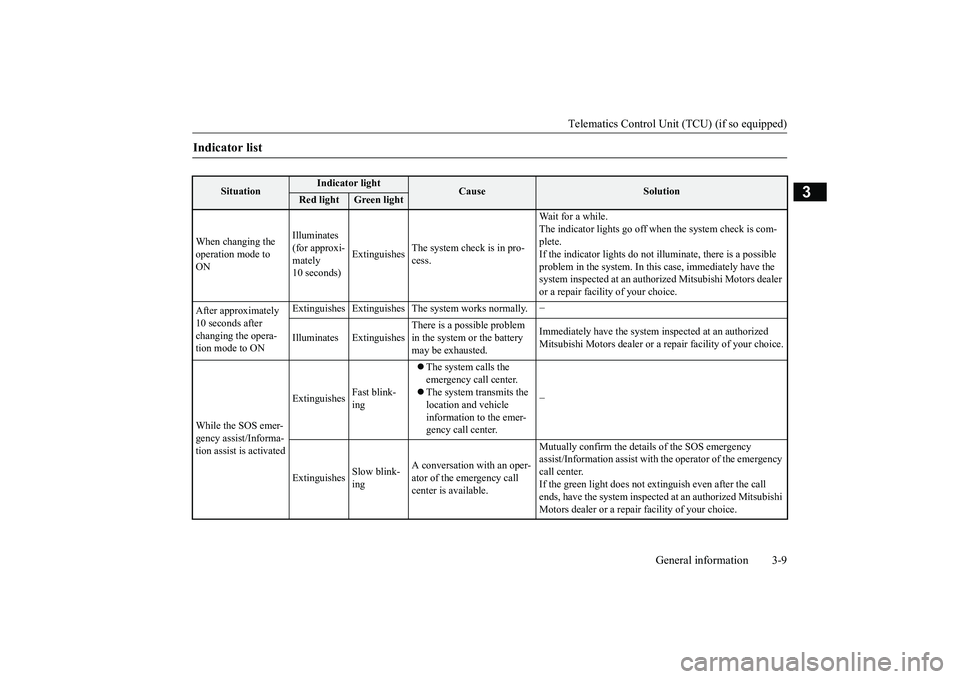
Telematics Control Unit (TCU) (if so equipped)
General information 3-9
3
Indicator list
Situation
Indicator light
Cause
Solution
Red light
Green light
When changing the operation mode to ON
Illuminates (for approxi- mately 10 seconds)
Extinguishes
The system check is in pro- cess.
Wait for a while. The indicator lights go off when the system check is com- plete. If the indicator lights do not illuminate, there is a possible problem in the system. In this case, immediately have the system inspected at an authorized Mitsubishi Motors dealer or a repair facility of your choice.
After approximately 10 seconds after changing the opera- tion mode to ON
Extinguishes Extinguishes The system works normally.
−
Illuminates Extinguishes
There is a possible problem in the system or the battery may be exhausted.
Immediately have the system inspected at an authorized Mitsubishi Motors dealer or a repair facility of your choice.
While the SOS emer- gency assist/Informa- tion assist is activated
Extinguishes
Fast blink- ing
The system calls the emergency call center. The system transmits the location and vehicle information to the emer-gency call center.
−
Extinguishes
Slow blink- ing
A conversation with an oper- ator of the emergency call center is available.
Mutually confirm the details of the SOS emergency assist/Information assist with the operator of the emergency call center.If the green light does not extinguish even after the call ends, have the system inspected
at an authorized Mitsubishi
Motors dealer or a repair facility of your choice.
BK0266800US.bo
ok 9 ページ 2018年6月27日 水曜日 午後5時6分